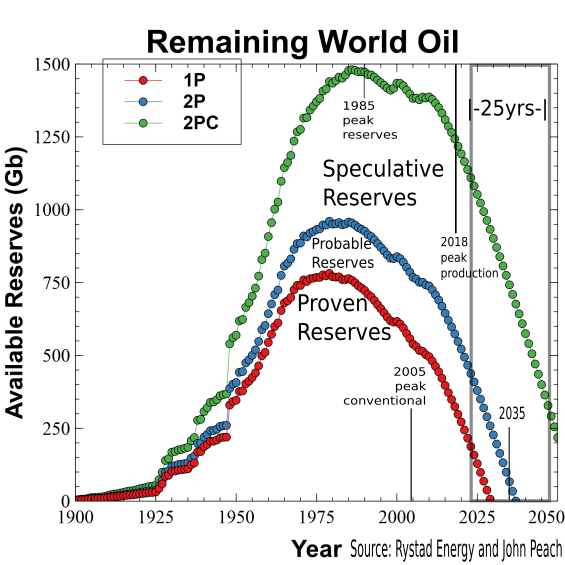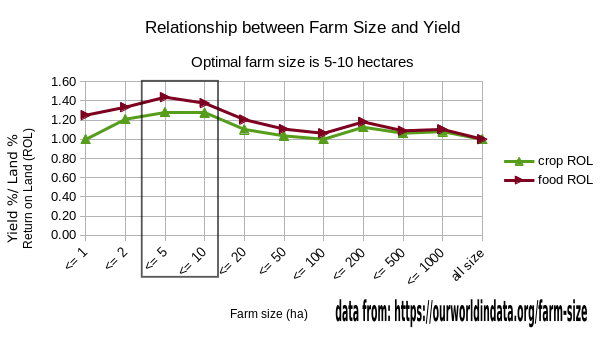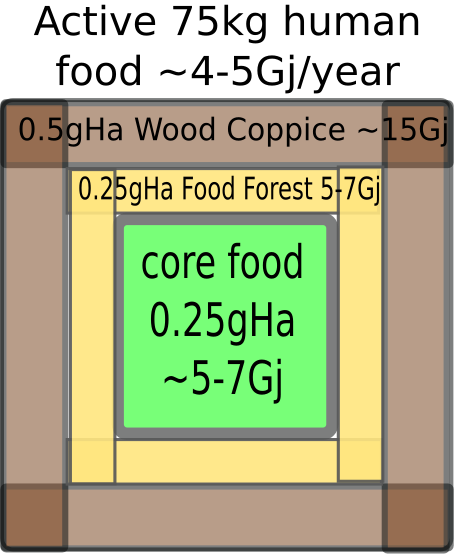Future Timelines:
What do we do after the Oil is gone?

You may have heard of “peak oil” back in the 1970’s it was peak reserves, and peak production of US conventional crude. Peak Oil production globally was reached in 2018. Nowadays pundits talk about “peak demand” an imaginary concept to avoid admiting peak oil reserves and production is in the past.
Globally we only have about 8 years of proven oil reserves. Notably for people to live in a city, requires more fuel calories for tractors, fertilizers, pesticides and trucks to produce and transport food than is contained in the food. While we do also have natural gas and coal reserves, they can not be easily exploited without cheap oil, and they are also depleting rapidly. We can’t build nuclear fast enough to replace fossil fuels before they run out, nor the reserves to fuel them. We do have the opportunity to put nuclear waste into pyramids with thermoelectric couplers to give limited power for thousands of years. Renewables and nuclear are unable to provide enough energy to replace our current use. The tar sands return on investment is no better than solar panels, which has the lowest return of the renewables. All modern renewables except hydropower and concentrated solar power have returns no better than firewood which we had in pre-industrial times.

Pre industrial cities typically can only support 10% of the population in the cities, from the surplus of 90% living in the rural areas. In most positive scenarios we can expect mass outmigration from cities to the rural areas. We know that globally the optimal farm size for food production is between 5-10 hectares. This is based on taking the percentage yield statistics of farms of a certain size and dividing it by the percentage of land they occupy. The reason for this is many, but suffice to say that it is the optimal amount of land that a family can cultivate a loving and personal relationship with.
Limits to Growth study by the Club of Rome 1 in the 1970’s foretold with rather good accuracy that things would begin to decline in 2015, and start to really decline in 2020, and be racing downhill until they bottom out sometime in the 2030s. So far we are considered on track with the initial business as usual scenario.
1 Near Term Projections
1.1 Scarcity Industrialism
Near term we are entering a phase known as "scarcity industrialism", already quite prevalent in Europe. Where the main focus is on conserving energy to keep critical infrastructure and services running. This is done through increasing insulation and rationing. While fluctuations in the price of energy are expected, the general trend is upwards. Some projections say that by 2030 the global EROI of fossil energy fuels will dip below 11, meaning automobile economy will become increasingly non-viable for a majority of consumers. Within the next 14-40 years fossil carbohydrate reserves will deplete to a level that they become uneconomical to use as energy, and we’ll transition to the salvage economy.
1.2 Salvage Economy
The salvage economy is characterized by the fact that the most valuable commodities become those which have embedded energy, from those times when energy was cheap. For example metals and plastics which were made during times of energy abundance, can be recycled into new products for much less energy than it takes to smelt ore to make the metals. During the salvage economy the most valuable areas become scrapyards, landfills and abandoned infrastructure. Salvage economy is already prevalent in many countries of the world.
2 Long Term Projections
The "Mass Dreams of the Future" study by Dr. Helen Wombach, Dr. Chet Snow and others in the 1980’s future progressed a couple thousand people to the years 2100CE-2500CE and found 4 distinct timelines or viable lifestyles.
Here will begin with the ones that have the shortest life expectancy and worst subjective ratings of well being, and progress to those that have better life expectancy and subjective ratings of well being. Notably in the projections from the 1980’s found a global population decline of around 94% by the year 2100, which is a total measured in hundreds of millions of people. So plenty of room for anyone who is prepared to forgive and love all beings including themselves and transition to a sustainable lifestyle in co-operation with nature. While certainly it is possible that everyone will transition to a sustainable lifestyle, as our planet has enough food forest capable land to support up to 12 billion people via permaculture. However that is rather improbable as that would mean giving everyone on the planet enough land to grow their own food, firewood and clothing, and train them how to use it, all before oil runs out. But we can accomplish it at least at a local level.
The following lifestyles are considered viable in the most probable scenarios assuming current trends continue in the business as usual sense.
2.1 Urban Lifestyle
Those who lived an urban lifestyle in 2100s generally found themselves in an RCP8.5 scenario where the biosphere was destroyed, and so people lived underground, wearing prison uniforms (jumpsuits), and involved in a strict and violent hierarchy, where most people died young, often from asphyxiation outdoors due to suit failures. They ate mostly synthetic food and pills. They did have access to technology and could even travel to space. Average life expectancy was 52. The easiest way to join this timeline is to promote urban growth, and-or join the military such as the Space Force. In some of the less energy intensive lifestyles urban settings were mostly a place for salvaging supplies to take to their rural encampments. After the 2300s peaceful small cities begin to appear, seemingly an offshoot of the Sylvan lifestyle described below.
2.2 Rustic Lifestyle
The rustic lifestyle may be familiar to you as that of the Old order Amish or Old order Mennonites, wearing traditional Amish garb and characterized by a life filled with hard work from before the sun rises until after the sun sets, plowing fields, annual agriculture, and animal husbandry, resting on Sundays to go to Church. It is considered the most probable lifestyle in the near future of southern Ontario, average life expectancy is 57. The easiest way to join this timeline is to forgive and love the old order mennonites/amish and transition to their ways.
2.3 Indigenous Lifestyle
The indigenous or "survivalist" lifestyle consisting of living in the wilderness and subsiting on hunting and gathering, typically wearing fur or bark clothing in remote wilderness areas such as Ontario’s North, actually requires less effort than the Rustic lifestyles. Hunter-gatherers around the world typically only spend about 3-4 hours a day engaged in labour. As a result of the more relaxed lifestyles, the life expectancy is 71 years, which is around what it was historically for hunter-gatherers that live past the age of 5. The easiest ways of joining this timeline is moving to a wilderness area and living off the land, preferably with indigenous peoples or others who know what they are doing.
2.4 Sylvan Lifestyle
Somewhat of a hybrid of the preceding lifestyles the New Age Sylvan lifestyle people live in spiritually-focused food forest communities and typically wear robes. Similar to the indigenous lifestyle it is fairly low effort, as trees and shrubs produce year after year, with a continuous harvest season as different fruits, tubers, leaves and nuts ripen all within a short walk of one’s home at different times of year. Similar to Anabaptists they are quite spirtual and typically have telepathic contact and trade relations with extra terrestrials and spiritual entities like Jesus. The average life expectancy in 2100 is 89 and by the 2300s it rises to 99 years. By the 2500’s it becomes the most populous lifestyle across the globe. The easiest way to join is to cultivate forgiveness, compassion and unconditional love for all beings including yourself and nature, and make it easier for people to grow food forests, live in communities, and have diverse spiritual practices. The New Age Sylvan lifestyles seem to be originate at mountainous regions with thin soils where tree based permaculture is the most reliable. Grey County similarly is one of the hilliest parts of south Ontario and tends to have fairly thin soils which can’t take much plowing before they become unusable for annual agriculture, and thus are easiest to use with tree based permaculture. Wel also have many waterfalls which can be used for hydro electric generators and maker spaces that can recycle and produce metal and plastic tools as well producing looms and sewing machines.
3 Policies
Upon consultation with the Grey County planners, they have mentioned that currently it would be possible to have sustainable farm sizes of 5-10 hectares in rural zoned areas. Permission from the province would be required to expand creation of sustainable farm sizes into agricultural zoned areas. MPP Rick Byers says the GCFA, BCFA, and OFA are in charge of agricultural plot sizes. BCFA president says it’s up to the county official plan.

A global hectare which has 6 month growing season is enough to provide for the food, firewood and clothing of an individual in perpetuity, with roughly half of the land being designated for growing firewood, at least a quarter being used to produce food for one person, and the other quarter being used to produce a surplus. In Grey County we have a 5 month growing season so a global hectare equivalent would be closer to 1.2 hectares per person. A family of 4 or 5 would thus need a 5 or 6 hectare lot, assuming no livestock beyond small animals.
The optimal community size for social cohesion is considered to be between 50-60 people. The majority of Amish/Mennonite congregations average around 60 people. The upper bound on community cohesion is around 150-200 people. Beyond that it is generally necessary to have a hierarchy to avoid inter-community rivalry by providing arbitration and peace keeping services.
Politics has potential pitfalls where someone could think that they know better what someone else needs than that person does. At that point politics stops being of service to other, and becomes a service-to-self paradigm that serves the politican. So it is important to avoid any form of coercion or force in politics and instead to cultivate forgiveness, compassion and love for all beings. The only service-to-others approach I’m aware of is providing people opportunities, and letting them choose, including making up their own option, or continuing to do what they are already doing. In this way can naturally increase adaptive capacity, as there is an increase in the different lifestyles which are attempted.
One of the issues in politics on Earth today is that representatives often "represent" far more people than they could possibly know in person. As a solution to this can have a more refined system with more levels. For example if communities average 60 people, then 6 communities can make a village of 360 people, or 360 hectares from a planning perspective. Then 14 villages make a neighbourhood of 5040 hectares. And 11 neighbourhoods make a municipality of 55440 hectares. We can fit 8 such municipalities in Grey County. someone who is elected at the village level, is then eligible to be elected as leader by the local neighbourhood, and neighbourhood leaders are eligible to be elected as municipal leaders, and municipal leaders are eligible to be elected as county leader. The staff for an elected official would be from among the members of their community. The county leader only needs to maintain relationship with the 60 people of their community, 6 other community leaders, 14 village leaders, 11 neighbourhood leaders and 8 municipal leaders, yielding a total of a mere 99 relationships, so quite manageable.
As we know from the "Dictator’s Handbook" by Bruce Mesquita and Alastair Smith that politicians represent the interests of the people who keep them in power. So favoritism of their home village/neighbourhood/municipality is to be expected, and some kind of rotation is advisable. To minimize adverse effects, can raise a red flag figuratively or literally whenever phrases such as "for their own good" or any kind of coercion/manipulation is discussed since that is the path of fear/anger/control the service-to-self path, and in order to have a good future we need to be following the service-to-others path of forgiveness, compassion and unconditional love.
MPP Rick Byers says that while the province doesn’t plan to do a top-down reorganization, any kind of bottom-up reorganization is permissible.
3.1 Conclusion
In Conclusion the most important thing is to forgive, love and be kind to one another. When you see a homeless person on the street, recognize that they too have the spark of God within them and deserve enough land to grow their own food, firewood and clothing. Jesus said that how you treat the least of your brethren is how you treat God (Matt 25:40), and the Confederation of Planets agrees. For entrance into the confederation of planets as a society we would need to achieve peace and sustainability within our own area.
If there is a fear/anger the recommendation is to sit with it in meditation, let it expand to its maximal proportions, and find the seed of love within it, and let that seed grow to fill and overflow the extent. For example if one is afraid of a change of circumstance, one can see what is being held onto with love, and one can then envision that loved artifact in the new circumstance, healthy, alive and well, perhaps in a new incarnation.
Many councilors may be getting up in years at this time, and you can rest assured that with an open heart, love and kindness you will be able to graduate into larger life with dignity. For it is not what you accomplish in the illusion that you can take with you, but what you accomplish in your soul, the heart of your being. Beyond that you can reap the rewards of creating a more equitable and harmonious existence in your future incarnations on Earth. Indeed you will be able to incarnate amongst the least of your brethren, to learn greater compassion for their plight. So it is best to make sure everyone has a good life, with enough land to meet their needs.
All is well, and all will be well my friends. I am Andrii. This transmission is at an end now, May you glorify in the love and in the light, rejoice in the power and in the peace of the One Infinite Creator. Adonai vasu borragus